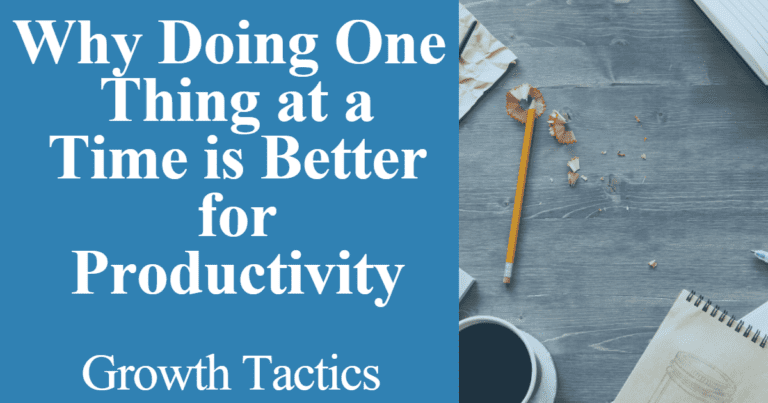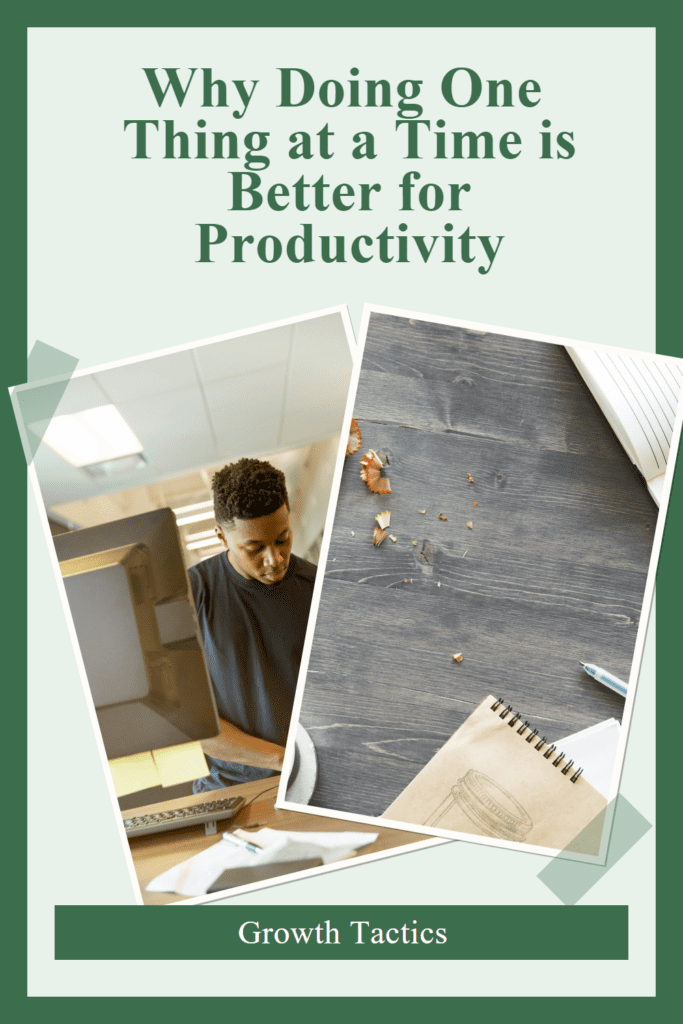Do you ever feel like you’re constantly juggling multiple tasks at once, trying to stay on top of everything? It’s a common occurrence in today’s fast-paced world.
However, have you considered the benefits of focusing on just doing one thing at a time? In this article, we’ll explore the concept of single-tasking and discover why it can lead to greater productivity and overall success.
Jump To Section
What is Single-Tasking?
Welcome to the wonderful world of single-tasking! If you’re tired of feeling overwhelmed by a never-ending to-do list and constantly juggling multiple tasks, then this is the concept you’ve been waiting for. Let’s dive right in and explore what single-tasking is all about.
Definition of Single-Tasking
Single-tasking is the practice of focusing on just one task or activity at a time, giving it your undivided attention and effort. It involves deliberately avoiding distractions and resisting the urge to multitask.
Instead of spreading yourself thin by attempting to tackle multiple tasks simultaneously, single-tasking encourages you to prioritize and devote your full focus to one task before moving on to the next.
Benefits of Doing One Thing at a Time
Now that we know what single-tasking means, let’s delve into the incredible benefits it brings to our lives and productivity.
Enhanced Focus and Concentration
When you dedicate your attention to a single task, magic happens. Your focus sharpens, allowing you to dive deep into the task at hand. By eliminating distractions and honing your concentration, you can tap into a state of flow and achieve a higher level of productivity. Your ability to absorb and process information improves, leading to better decision-making and problem-solving.
Increased Efficiency and Quality
When multitasking, our brains constantly need to switch gears, which can be mentally exhausting. The beauty of single-tasking is that it eliminates the need for constant context-switching. By focusing on one task at a time, you streamline your thought process and workflow, resulting in increased efficiency.
Moreover, since you’re dedicating your full attention to each task, the quality of your work also improves. Say goodbye to rushed, half-hearted efforts— single-tasking allows you to produce your best work.
Reduced Stress and Overwhelm
The never-ending cycle of multitasking can leave you feeling drained, stressed, and overwhelmed. By adopting a single-tasking approach, you regain a sense of control and peace. Instead of constantly juggling tasks and battling time constraints, you can approach each task with a calm and focused mindset.
This reduction in stress levels not only improves your overall well-being but also allows you to tackle your tasks with a clearer and more composed mind.
Improved Time Management
Single-tasking goes hand in hand with effective time management. By focusing on one task at a time and prioritizing your work, you gain a better understanding of how you spend your time.
You become more intentional with your scheduling, optimizing your productivity and ensuring that each task receives the attention it deserves. As a result, you can accomplish more in less time, giving you the freedom to truly savor life outside of work.
Boosted Creativity and Innovation
When you’re fully immersed in a single task, your mind has the space to wander, explore, and generate creative solutions. Single-tasking allows you to tap into your inner creativity and innovation.
By dedicating uninterrupted time to a project, you can think outside the box, connect ideas, and come up with groundbreaking solutions. It’s like unlocking the full potential of your imagination!
How Does Focusing on One Task Improve Productivity?
In this section, we’ll explore the impact of focusing on a single task, compare it to multitasking, delve into the scientific evidence supporting this practice, and even touch on the psychological aspects of single-tasking for productivity. So, let’s dive in!
Impact of Focusing on One Task at a Time
Our brains are remarkable, but they aren’t designed to handle multiple tasks simultaneously. When we try to multitask, we’re actually switching our attention back and forth between tasks, which can be mentally exhausting.
By focusing on one task at a time, we allow ourselves to fully immerse in that particular activity, promoting greater concentration and productivity.
Comparison between Single-Tasking and Multitasking
It’s important to understand the key differences between single-tasking and multitasking. When we multitask, our attention becomes divided, and we tend to perform each task less efficiently.
On the other hand, when we focus on one task, we can dedicate our full attention and effort, resulting in better quality work and faster completion times.
Scientific Evidence Supporting Focused Task Completion
The benefits of single-tasking have been backed by scientific research. Studies have shown that individuals who focus on one task at a time experience reduced stress levels and improved cognitive performance.
Additionally, single-tasking has been linked to increased creativity, as our minds are able to delve deeper into a specific task, allowing for more innovative ideas to flow.
Psychological Aspects of Single-Tasking for Productivity
From a psychological standpoint, single-tasking can have significant positive effects on our well-being and productivity. When we concentrate on a single task, we enter a state of flow, where time seems to fly by, and we become fully absorbed in what we’re doing.
This state of flow leads to a sense of accomplishment and satisfaction, which can motivate us to tackle other tasks with equal focus and determination.
Tools for Practicing Single-Tasking
Okay, so you’re sold on the benefits of single-tasking. You’re ready to dive in and achieve greater productivity, creativity, and focus.
But where do you begin? How do you make single-tasking a habit?
Fear not, my friend, for I’ve got some tools and tips to help you on your journey to single-tasking success!
Digital Tools
In a world that runs on technology, it’s no surprise that there are digital tools to support single-tasking. Here are a few of my favorites:
1. Time Tracking Apps
By tracking your time, you can identify where your attention goes and how much time you’re really spending on each task. Time-tracking apps like RescueTime, Toggl, and Clockify help you track your workday, give you meaningful insights about your productivity, and even help you curb time-wasting habits.
2. Focus Apps
If you’re easily distracted or need help staying on task, focus apps can be a lifesaver. Freedom and Cold Turkey are two examples of apps that block distracting websites, games, or social media during times you want to stay focused.
3. To-do Apps
To-do apps like Things, Todoist, and Trello can help you manage your tasks and keep them organized without overwhelming you. These tools can help set priorities, create schedules, and add reminders to keep you on track.
Analog Tools
If you prefer to go old school, there are plenty of low-tech tools that can help you practice single-tasking.
1. Sticky Notes
Sticky notes are a simple but powerful tool for staying focused on one task at a time. Write down tasks that need to be accomplished and stick them in a visible spot. Once a task is complete, toss the sticky note and move on to the next item.
2. Timer
A timer can help you stay on track and create a sense of urgency. Set a timer for a certain amount of time, and focus on one task until the timer goes off. Then, take a short break before diving into the next task.
3. Notebook
Sometimes the best way to single-task is to completely unplug. Grab a notebook and pen, and write down what needs to be done. Prioritize the tasks, and tackle them one by one. The act of physically crossing off completed tasks can be incredibly satisfying!
Mindset Tips
At the end of the day, single-tasking is just as much a mindset as it is a tool. Here are some mindset tips to help you stay focused and motivated.
1. Prioritize Your Tasks
Identify the most important tasks and work on those first. By prioritizing, you create clarity and focus, allowing you to single-task more effectively.
2. Embrace Silence
In a world full of noise, it can be difficult to find moments of silence. But when you purposely seek out moments of quiet, you open up space for focus and clarity. When you single-task, try to find a quiet place, eliminate distractions, and enjoy the moment of peace.
3. Practice Mindfulness
Mindfulness is the practice of being present in the moment. When you’re single-tasking, strive to be fully present and engaged in what you’re doing. Engage all your senses and try to fully experience the task at hand.
There you have it— digital tools, analog tools, and mindset tips that can help you embrace single-tasking. By utilizing the tools that work best for you and adopting a focused mindset, you’ll be well on your way to increased productivity, creativity, and overall well-being. Happy single-tasking!
Best Practices for Single-Tasking in a Multitasking World
In a world filled with distractions and demands, mastering the art of single-tasking can be a game-changer for productivity and well-being. But how can we effectively single-task when the world around us encourages multitasking?
Fear not, my friend! In this section, I’ll share with you some best practices for single-tasking in a multitasking world. Let’s dive in and reclaim focus and productivity!
Prioritize and Plan
Start by identifying your most important tasks and prioritize them accordingly. Create a to-do list or use a productivity tool to keep track of your tasks. By planning ahead and focusing on what truly matters, you’ll be able to allocate your time and energy more effectively.
Set Clear Goals for Each Task
Before diving into a task, define what success looks like. By setting clear, specific goals, you give yourself a target to aim for. This clarity helps maintain focus and ensures you’re making progress towards your desired outcomes.
Minimize Distractions
In a world full of distractions, creating a conducive environment for single-tasking is crucial. Minimize external distractions by turning off notifications, closing unnecessary tabs, and silencing your phone. Find a quiet space or use noise-cancelling headphones to help you stay focused.
Use Time Blocking
Time blocking is a powerful technique that involves dedicating specific time blocks to focus on a single task or group of related tasks. By carving out designated periods for focused work, you create a structured framework that supports your single-tasking efforts.
Practice Deep Work
Deep work is all about immersing yourself fully in a task, free from distractions. Set aside dedicated blocks of time to engage in deep work, where you shut out external interruptions and dive deep into the task at hand.
This deep focus allows you to produce high-quality work and tap into your creativity.
Practice Mindfulness
Mindfulness can be a powerful tool to combat distractions and strengthen your ability to maintain focus. Incorporate mindfulness practices into your routine, such as deep breathing exercises or short meditation sessions, to cultivate a calm and focused mindset.
Take Regular Breaks
While single-tasking is about dedicating focused time to a task, it’s also important to take regular breaks.
Breaks provide an opportunity to recharge your brain, prevent burnout, and maintain productivity throughout the day. Use your breaks to stretch, move around, or engage in activities that rejuvenate you.
Embrace Imperfection
Remember, perfection is not the goal here. Aim for progress, not perfection. It’s natural to get distracted or encounter setbacks along the way. Be kind to yourself, acknowledge those moments, and gently refocus on the task at hand.
Celebrate Your Achievements
Finally, celebrate your accomplishments! Recognize and acknowledge the progress you’ve made. Celebrating small wins can boost your motivation and reinforce the habit of single-tasking.
In Summary
In a multitasking world, practicing single-tasking can be a transformative way to enhance focus, productivity, and overall well-being.
By prioritizing, setting clear goals, minimizing distractions, using time blocking, embracing deep work, practicing mindfulness, taking breaks, and celebrating achievements, you’ll be well on your way to mastering the art of single-tasking.
Embrace the power of focused attention and reclaim control over your tasks and time. You’ve got this!


